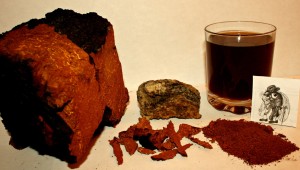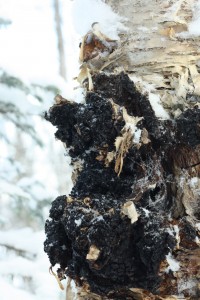Healing Properties of Chaga Fungus

Is this true? Inquiring minds want to know! Chaga, scientifically called inonotus oblquus, has been used in Chinese medicine for thousands of years, and its use in Eastern European folk medicine has been documented since the 16th century.
People have used it as tea, smoked it, and made salves to use externally.
Like a plant world version of that critter in the movie “Alien”, the chaga fungus invades a tree , usually birch (although it has been found on alder, hornbeam, beech and chestnut trees as well) through a wound in the bark and slowly grows, until it eventually bursts out of the tree looking like a big, dark tumour. You’ve probably seen them yourself on the sides of birch trees, but didn’t know what they were.
It only grows in cold climates, so it can be found on birch trees across Canada.
Once a tree is infected with this fungus the tree is doomed…. but, in the years before it finally succumbs, as the host tree battles the fungus it absorbs medicinal constituents from the defence mechanisms of the tree.
My internet research safari revealed all kinds of information! From the breathless hype of companies claiming the stuff to be the mushroom of immortality to debunkers crying foul, chaga has in fact been the subject of actual recent scientific research.
Joe Gee brought me a big chunk of chaga as a birthday gift a couple of weeks ago, so I’ve been drinking the tea. It’s too soon to tell if I’ll live forever, so I’ll just share with you some of the research I came across!

Joe Gee photo
It’s helped people counter the side effects of cancer treatments, and there is some evidence that it may even have anti-cancer potential, especially in the early stages of the disease.
It has no side effects itself, it is completely safe to consume, but if one were taking immune suppressing drugs, like in the cases of organ transplant, you wouldn’t want to take chaga because it might neutralize the drug’s effects.
It’s been traditionally used in folk medicine to treat gastritis and gastrointestinal problems. It is anti-oxidant and anti-aging….research has shown chaga to possess DNA regenerating and revitalizing properties.
It is an anti-inflammatory as well. I have a cousin who has been drinking chaga tea to alleviate the chronic pain she was suffering from arthritis in her knees. She reports that the stuff works…she can actually walk without pain these days. She was, in fact, contemplating knee replacement surgery but has put that plan on hold since she began using chaga!
Chaga has been found to normalize cholesterol levels, is beneficial to the cardiovascular system and supports healthy blood pressure.
As awareness of chaga has increased, it has been ruthlessly harvested. Although it is true that a host tree will eventually die, the chaga can still be harvested sustainably.
If you want to try chaga for yourself, and know where to find some in the woods, only harvest the larger conks. Leave little fist sized conks to grow! Usually a conk will pop off a tree with the blow of an axe.
Don’t dig it out, though, to get every bit out of the trunk. Doing so will kill the tree a lot sooner, and if you leave some chaga behind, it will grow back so it can be re-harvested again in the future.
Chaga is easier to find in the winter, with all the leaves gone. However, many times the best and biggest conks will be found 20 or 30 feet up the tree!
Some researchers are experimenting with cultivating chaga commercially as the market for medicinal mushrooms and fungus is exploding as people learn more about the amazing benefits of many of these compounds.
There’s a lot of conflicting information on the best way to brew chaga. Some references recommend simmering it for hours in a crock pot, but I’ve simmered it for 20 minutes in a stainless pot and it seems pretty strong. The tea turns quite dark, and, the chaga bits can be re-used several times….don’t throw them out after one use! Let them dry out and you can re-brew them. Don’t use anything reactive to brew your tea in…use glass, ceramic or stainless steel.
The chunk I’ve been experimenting with makes a tea that has a very mild smoky flavour. I’ve read that some folks find it to have a maple flavour. Perhaps every conk has its own unique flavour!
If you have a chaga story or experience to share, please let us know!
